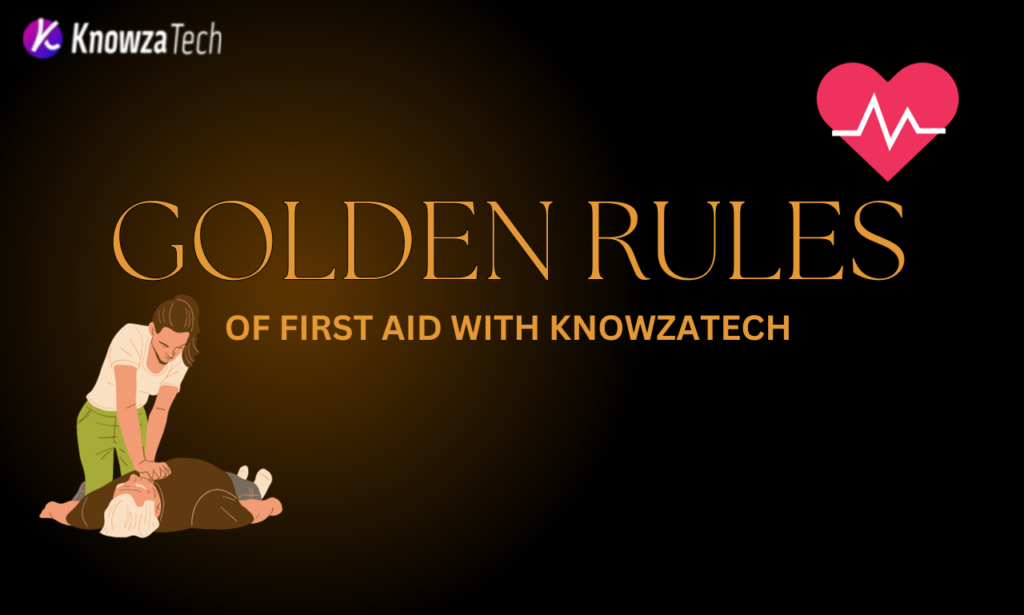The golden rules of first aid refer to a few basic guidelines that should be followed in any medical emergency situation. First aid providers recommend having a quick mental checklist of these key actions to take confidently until additional help arrives.
The Golden Rules of First Aid
As an essential life skill, first aid can make all the difference during medical emergencies. But with so much information out there, it’s easy to get overwhelmed. That’s why experts recommend focusing on a few key golden rules that will serve you well no matter the situation. Follow these tried-and-true guidelines and you’ll be empowered to offer quick and confident care.
Stay Calm
– In any emergency, panic and stress will only hinder clear thinking. Take a deep breath and assess the scene calmly before acting. Remain soothing and reassuring for the injured person.
Ensure Safety
– First make sure there is no further danger, like live wires or traffic. Only then attend to the casualty without putting yourself at risk. Safety is the number one priority.
Check Response
– Gently shake their shoulders and ask if they are okay. Note if they are conscious, breathing normally and can respond appropriately. This vital information will guide your next steps.
Call for Help
– Have someone dial the emergency number right away. Even if you begin care, additional medical help may be needed, so get the authorities notified as a top priority action.
Stop Bleeding
– For any severe bleeding, apply firm and direct pressure over wounds using a clean cloth. Elevate the injury if possible to reduce flow. Bleeding must be controlled as a life-threatening issue.
Check Airway
– Make sure the person’s mouth and throat are clear to allow normal breathing. Tilt the head gently and look inside to check. Clear the mouth only if required.
Provide Comfort
– Speak calmly, keep the person still and warm, and monitor until advanced help arrives. Your comforting presence and care could make all the difference during shock or trauma.
Control Bleeding
– For external bleeding, apply firm pressure directly on the wound using a clean dressing or cloth. Elevate the injury if possible to reduce blood flow. Tie it in place securely and do not remove until medical help arrives.
Check Circulation
– Feel for a pulse and check skin color, temperature and condition. Signs of circulation issues like pale or blue skin require immediate medical attention.
Prevent Shock
– Have the person lie down with legs elevated if possible. Maintain normal body temperature by covering them with a blanket or coat. Reassure them and seek urgent help for signs of going into shock like dizziness or confusion.
Handle Carefully
– Move or touch the person as minimally as required. Immobilize serious injuries like suspected fractures using whatever materials are available like a splint or scarf before transporting.
Document Details
– Note the time of injury, what happened, signs and symptoms, and any first aid given. Share this clearly with responding medical personnel so they can continue appropriate care.
Questions related to this topic :
Question no 1 : What are the golden rules of first aid?
- Ensure scene safety
- Check consciousness
- Control severe bleeding
- Call for emergency help
- Check breathing
Potential quotes from experts on golden rules of first aid:
“The golden rules are tried and true – they’ve saved lives for decades. When seconds count in an emergency, having guidelines you can easily remember is critical. It allows you to assess the situation and take lifesaving action fast.” – Dr. Mary Smith, American Red Cross Medical Director
“As a paramedic, I’ve seen firsthand how the golden rules set people up for success when trying to help someone injured. Getting scene safety and controlling severe bleeding taken care of right off the bat buys us valuable time to work. First aiders who follow these basics have always provided the best care before we arrive.” – Josh Williams, 15-year Paramedic
“No matter your level of training, the golden rules empower everybody to help in a crisis. They distill first aid down to the essentials – things the average person can recall and act on. That confidence and competence makes all the difference when responding to save another human life.” – Dr. Raymond Chen, American Heart Association Medical Director


1 thought on “The Golden Rules of First Aid for Optimal Safety”
Pingback: Air Charter Bend Oregon : Convenient and Luxurious Private Flight